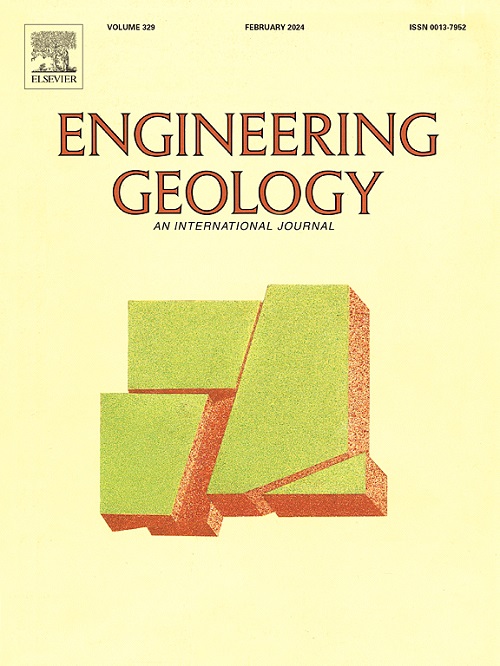降雨和水库水位效应下的滑坡变形机制和耦合效应分析
IF 6.9
1区 工程技术
Q1 ENGINEERING, GEOLOGICAL
引用次数: 0
摘要
降雨量、地下水位和水库水位的变化会加剧涉水滑坡的变形,加速滑坡从演变到消亡的过程。从大量监测数据中提取滑坡的破坏规律,了解其整体变形机理,对于地质灾害防治至关重要。在此,我们以三峡库区九仙坪滑坡为例,提出了基于监测数据挖掘技术的涉水滑坡变形机理分析模型。研究利用格兰杰因果关系检验,分析了三个不同剖面的 GPS 位移数据的时空特征,证实了九仙坪呈现出牵引破坏模式。通过比较不同剖面的 GPS 位移数据及其格兰杰因果关系,揭示了滑坡在演化过程中前部、中部和尾部的分段滑动特征。此外,我们还确定了诱发因素(降雨和水库水位变化)对滑坡位移的影响强度。根据Ⅱ-Ⅱ′剖面的 GPS 位移数据,建立了用于滑坡位移多源预测的经验模式分解-长短期记忆-回归模型(EMD-LSTM-回归)。采用 Shapley 加性解释算法分析了降雨和水库水位变化对滑坡体不同位置周期性位移的影响。由于九仙坪滑坡面积较大,不同位置对诱发因素的反应也不尽相同。在全球气候变暖、极端天气频发的背景下,这些研究结果为三峡库区预防和缓解与水有关的滑坡提供了重要的启示,同时也为分析全球与水有关的滑坡变形提供了新的视角。本文章由计算机程序翻译,如有差异,请以英文原文为准。
Analysis of landslide deformation mechanisms and coupling effects under rainfall and reservoir water level effects
Changes in rainfall, groundwater levels, and reservoir water levels exacerbate the deformation of water-involved landslides, accelerating the transition from landslide evolution to extinction. Extracting the destruction patterns of landslides from extensive monitoring data, and understanding their overall deformation mechanisms are crucial for geological hazard prevention and control. Herein, we took the Jiuxianping landslide in the Three Gorges Reservoir area as an example and proposed a deformation mechanism analysis model for water-related landslides based on monitoring data mining techniques. Using Granger causality testing, the study analyzes the spatiotemporal characteristics of GPS displacement data from three different profiles, which confirms that Jiuxianping exhibits a traction destruction mode. By comparing GPS displacement data and their Granger causality relationships across different profiles, we reveal that segmented sliding features of the landslide's front, middle, and trailing during its evolution. Furthermore, the impact intensity of triggering factors (rainfall and reservoir water level changes) on landslide displacement was identified. Based on GPS displacement data from profiles II–II′, an empirical mode decomposition–long short-term memory-regression model (EMD-LSTM-regression) is developed for multisource prediction of landslide displacements. The Shapley additive explanations algorithm is used to analyze the influence of rainfall and reservoir water level changes on periodic displacements at different positions of the landslide. Owing to the large area of the Jiuxianping landslide, the response to triggering factors varies across different locations. In the context of global warming and frequent extreme weather events, these findings offer important insights for preventing and mitigating water-related landslides in the Three Gorges Reservoir area, while also providing new perspectives for the analysis of global water-involved landslide deformation.
求助全文
通过发布文献求助,成功后即可免费获取论文全文。
去求助
来源期刊

Engineering Geology
地学-地球科学综合
CiteScore
13.70
自引率
12.20%
发文量
327
审稿时长
5.6 months
期刊介绍:
Engineering Geology, an international interdisciplinary journal, serves as a bridge between earth sciences and engineering, focusing on geological and geotechnical engineering. It welcomes studies with relevance to engineering, environmental concerns, and safety, catering to engineering geologists with backgrounds in geology or civil/mining engineering. Topics include applied geomorphology, structural geology, geophysics, geochemistry, environmental geology, hydrogeology, land use planning, natural hazards, remote sensing, soil and rock mechanics, and applied geotechnical engineering. The journal provides a platform for research at the intersection of geology and engineering disciplines.
 求助内容:
求助内容: 应助结果提醒方式:
应助结果提醒方式:


